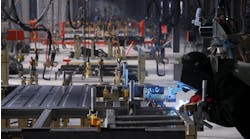A deeper dive into rationalizing cost, payback and the criticality of edge computing
Stratus Technologies' Jason Dietrich
At the recent ARC Industry Forum, a panel of industry experts gathered for the Stratus Workshop: Rationalizing Cost, Payback, and Criticality of Edge Computing for Industry 4.0 Automation Initiatives. Under the moderation of ARC’s Craig Resnick, the panel explored how edge computing is fundamental for achieving desired outcomes of digital transformation, but IT and OT leaders face the challenge of projects-prioritization during (and after) COVID.
We wanted to dive deeper, so we connected with Jason Dietrich, Stratus Technologies’ chief revenue officer, to learn more. Take a look…
Smart Industry: Is it still a challenge to rationalize—or justify—edge-computing spend? Why?
Jason: It’s always been critical for companies to gauge the value of technology investments, and what we saw pre-COVID was a focus on cost, outcomes and payback period. What we see now is a heightened focus on payback in nine months or less. Edge computing remains at the early stages of many company’s digital-transformation journeys, but the efficiency, flexibility, and elimination of downtime that it offers drives tremendous short- and long-term value.
Smart Industry: Can you share some methods to overcome this reluctance to commit?
Jason: Beyond the short payback time, edge solves two operational challenges that make it easy for teams to embrace. It solves the need to manage operations with fewer people and it converges IT and OT. Teams require fast deployment, plug-n-play integration to existing infrastructure; low maintenance and edge delivers the OT capability that meets IT requirements, and requires low touch and low maintenance.
Smart Industry: The phrase “standardizing edge computing” was explored during this workshop. What does this mean and how is it achieved?
Jason: Edge-computing projects are moving from customized, single use cases to projects that emphasize extensibility to support ongoing growth for businesses. As edge accelerates, and analysts like ARC project, organizations will need to standardize on performance requirements. We see them selecting proven edge platforms with roots in OT to meet their operational needs.
In terms of standardizing edge computing, companies should look for platforms that are simple to manage, autonomous to operate, and offer the cybersecurity and physical ruggedness to operate anywhere.
Smart Industry: How can establishing an automation standard boost profits?
Jason: The opportunity at the edge is two-fold—it ensures availability of critical equipment and processes, and it harnesses that data for insight. In the case of Rubberlite, which we focused on during this workshop, they deployed edge computing to eliminate downtime and standardize data, which contributed to an 80% reduction in off-grade material. This highlights how improving product quality and increasing customer satisfaction directly contributes to profit.
Smart Industry: What challenges exist in reaping quick wins with this approach?
Jason: Companies must do their research—both for the appropriate technology and a valuable edge computing vendor—and then be decisive to move to pilots. However, the challenge in reaping quick wins often lies more with people and processes than the technology.
Smart Industry: What most excites you about the immediate future of edge computing?
Jason: Edge computing is a tremendous opportunity for nearly every industry and is foundational to digital-transformation initiatives. Edge provides the data availability, connectivity, data capture even in remote locations, and computing power that enable Industry 4.0 capabilities, including AI and machine learning. Add in the ability to quickly modernize architectures and converge IT and OT, and edge takes digital transformation from 30,000 feet right to the ground level.




